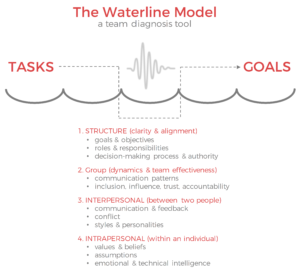
Things aren't always as they seem. We know this saying well; and yet, we continue to take things at face value. We trust our intuition and don't want to spend time digging deeper. So, instead, we assume that things are actually exactly as they seem and respond accordingly.
This happens in teams all the time. I recently partnered with a team who was facing some challenges. The group was comprised of talented, driven individuals who were all passionate about their work and appeared to genuinely care about each other. Seemed like a dream team; so why were they having trouble communicating and executing?
They assumed it was because of a few polarized personalities creating tense partnerships; so, naturally, they brought me in to facilitate a behavioral assessment and team-building workshop. We had great dialogue and breakthrough insights. Understanding and adapting to different styles is critical to effective teaming, but it can only do so much if there are other factors at play. With this team, understanding personality differences helped cut some weeds, but didn't pull the roots. Even those who don't garden know what happens when you don't pull the roots…
Using a tool can help you methodically and accurately diagnose team challenges. One of my favorite tools for this is the Waterline Model (Harrison, R., Scherer, J., & Short, R.R. (2001)). It's simple, but powerful. Here's how it works:
- As a team, individually and collectively, you are completing tasks to work toward common goals. Smooth sailing so far.
- Then, reality strikes and you hit a breakdown – the team struggles to make progress and/or faces conflict. You're stuck.
- It's time to dive below the waterline. To switch from a focus on task to a focus on structure, process, and people. Only then will you understand what's truly happening and how to effectively address it.
- The model identifies four levels of group dynamics. Start at the top and move down. Our human tendency is to point blame at an individual or at interpersonal differences, but breakdowns most often occur in the first two levels. This is not like a video game where you are rewarded for skipping levels – do not skip levels. I say it again, start at the top.

To help you effectively use the model, here are sample questions you may want to ask at each level. The Waterline Model will enable you to sort through issues your team may be facing in order to identify and address them accurately. Only then will you yank those roots out with the weeds.
team may be facing in order to identify and address them accurately. Only then will you yank those roots out with the weeds.
Remember, things aren't always as they seem. Good leaders ask a few questions to dig deeper. Great leaders strap on their goggles, dive below the waterline, and methodically search for causes and solutions. The best leaders take their teams on this journey with them.
In case you're wondering, I did not abandon the team mentioned above. They are now working hard below the waterline to clarify roles and decision-making processes. They will be un-stuck soon and moving full-speed ahead.






